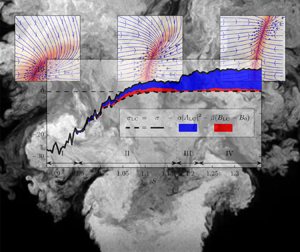Crossref Citations
This article has been cited by the following publications. This list is generated based on data provided by
Crossref.
Ahmed, Shady E.
Pawar, Suraj
San, Omer
Rasheed, Adil
Iliescu, Traian
and
Noack, Bernd R.
2021.
On closures for reduced order models—A spectrum of first-principle to machine-learned avenues.
Physics of Fluids,
Vol. 33,
Issue. 9,
Sieber, Moritz
Paschereit, Cristian Oliver
and
Oberleithner, Kilian
2021.
Impact of density stratification on the global mode in a swirling jet: Stochastic modelling and Lagrangian coherent structures.
International Journal of Heat and Fluid Flow,
Vol. 90,
Issue. ,
p.
108820.
Sieber, Moritz
Paschereit, Christian Oliver
and
Oberleithner, Kilian
2021.
Progress in Turbulence IX.
Vol. 267,
Issue. ,
p.
153.
Schubert, Yannick
Sieber, Moritz
Oberleithner, Kilian
and
Martinuzzi, Robert
2022.
Towards robust data-driven reduced-order modelling for turbulent flows: application to vortex-induced vibrations.
Theoretical and Computational Fluid Dynamics,
Vol. 36,
Issue. 3,
p.
517.
Indlekofer, Thomas
Faure-Beaulieu, Abel
Dawson, James R.
and
Noiray, Nicolas
2022.
Spontaneous and explicit symmetry breaking of thermoacoustic eigenmodes in imperfect annular geometries.
Journal of Fluid Mechanics,
Vol. 944,
Issue. ,
Callaham, Jared L.
Rigas, Georgios
Loiseau, Jean-Christophe
and
Brunton, Steven L.
2022.
An empirical mean-field model of symmetry-breaking in a turbulent wake.
Science Advances,
Vol. 8,
Issue. 19,
Litvinov, Ivan
Sieber, Moritz
and
Oberleithner, Kilian
2022.
Identification of the precessing vortex core in a hydro turbine model using local stability analysis and stochastic modeling.
IOP Conference Series: Earth and Environmental Science,
Vol. 1079,
Issue. 1,
p.
012052.
Pedergnana, Tiemo
and
Noiray, Nicolas
2022.
Exact potentials in multivariate Langevin equations.
Chaos: An Interdisciplinary Journal of Nonlinear Science,
Vol. 32,
Issue. 12,
Callaham, Jared L.
Loiseau, Jean-Christophe
and
Brunton, Steven L.
2023.
Multiscale model reduction for incompressible flows.
Journal of Fluid Mechanics,
Vol. 973,
Issue. ,
Zeng, Xin
Zhang, Yuyao
He, Chuangxin
and
Liu, Yingzheng
2023.
Time- and frequency-domain spectral proper orthogonal decomposition of a swirling jet by tomographic particle image velocimetry.
Experiments in Fluids,
Vol. 64,
Issue. 1,
Guan, Yu
Zhu, Yuanhang
Yang, Zhijian
Yin, Bo
Gupta, Vikrant
and
Li, Larry K.B.
2023.
Multifractality and scale-free network topology in a noise-perturbed laminar jet.
Journal of Fluid Mechanics,
Vol. 972,
Issue. ,
Krivonosova, O.
Gritsevich, M.
Zhilenko, D.
and
Read, P.
2023.
Noise induced effects in the axisymmetric spherical Couette flow.
Philosophical Transactions of the Royal Society A: Mathematical, Physical and Engineering Sciences,
Vol. 381,
Issue. 2246,
Wand, Tobias
Heßler, Martin
and
Kamps, Oliver
2023.
Memory Effects, Multiple Time Scales and Local Stability in Langevin Models of the S&P500 Market Correlation.
Entropy,
Vol. 25,
Issue. 9,
p.
1257.
Li, Xiao-Bai
Demange, Simon
Chen, Guang
Wang, Jia-Bin
Liang, Xi-Feng
Schmidt, Oliver T.
and
Oberleithner, Kilian
2024.
Linear stability and spectral modal decomposition of three-dimensional turbulent wake flow of a generic high-speed train.
Journal of Fluid Mechanics,
Vol. 1000,
Issue. ,
Sourav, Kumar
Majumdar, Dipanjan
and
Sarkar, Sunetra
2024.
Cross-flow vortex-induced vibrations of a circular cylinder under stochastic inflow at low Reynolds number.
Ocean Engineering,
Vol. 293,
Issue. ,
p.
116724.
Murali, Amal Roy
Kennedy, Mary Lidiya K.
Gryazev, Vasily
Armani, Umberto
Markesteijn, Annabel
Naghibi, Elnaz
Toropov, Vassili
Jacob, Marc C.
Hinkelmann, Reinhard
and
Karabasov, Sergey A.
2024.
Reduced Order Modelling of a Reynolds Number $10^6$ Jet Flow Using Machine Learning Approaches.
Colanera, Antonio
Reumschüssel, Johann Moritz
Beuth, Jan Paul
Chiatto, Matteo
de Luca, Luigi
and
Oberleithner, Kilian
2025.
Extended cluster-based network modeling for coherent structures in turbulent flows.
Theoretical and Computational Fluid Dynamics,
Vol. 39,
Issue. 1,
Hatzissawidis, Grigorios
Sieber, Moritz
Oberleithner, Kilian
and
Pelz, Peter F.
2025.
Data-driven spatiotemporal analysis of cloud cavitation by means of spectral proper orthogonal decomposition.
Experiments in Fluids,
Vol. 66,
Issue. 5,
Qin, Ziyu
Lin, Yuzhen
Song, Heng
and
Han, Xiao
2025.
Flow stability and complex network analysis in a swirl combustor with dump and slope confinement.
Energy,
Vol. 325,
Issue. ,
p.
135970.
